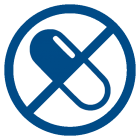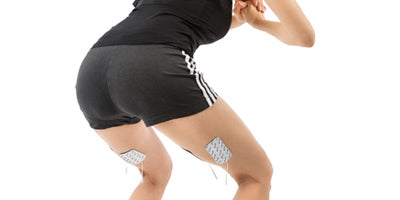EMS application overview

Depending on the muscle part to be trained by the electrical muscle stimulation, different electrode placements must be observed. View various examples of EMS training at home and find out how to ideally place the electrodes of an EMS device and which ones are best for EMS use.
You can train these muscle groups with an EMS device
-

Upper body
Your desired application is not included and you are unsure how to place the electrodes? Feel free to call us at any time , send us an email to customerservice@axion.shop or use our live chat.
What do you have to pay attention to during EMS training?
The following list gives you an overview of the special features you should pay attention to before EMS training:
Device quality : You need an EMS device with which you can achieve your training goals. In addition, for your safety, it should be officially tested and certified, recognizable by the CE mark.
Electrode quality : Rely on high-quality EMS electrodes instead of cheaper alternatives. The latter are often used up quickly and insufficiently checked. In addition, in many cases they do not transmit the current pulses properly. Find out how you can extend the life of the TENS EMS electrodes
Electrode Placement : Place the electrodes correctly. Usually, one electrode is placed at the base of the muscle and another is placed in the middle of the muscle. You can find more information about our devices in the enclosed information.
Training program and parameters : Make sure you choose the right training program or EMS parameters.
Functionality : Does the device offer an EMS program for the muscles you want to train? Good EMS trainers are also characterized by the fact that they also include TENS programs. This means you are ideally prepared in the event of aching muscles or injuries.
Recovery : A break of at least two days between training sessions is recommended. Exercising your muscles too often can lead to overtraining, which can be detrimental.
Tip:
If you want to achieve maximum success, you can use EMS during training . For example, do dumbbell workouts and support your biceps with EMS by performing the exercise in sync with the machine's impulses. An application while jogging or on the ergometer effectively combines endurance and strength training . In this way, you use your muscles in addition to regular training via the electrodes, whereby the current impulses should be slightly reduced.
This is how EMS training can also be done at home
EMS training is electrical muscle stimulation, in which impulses from an EMS device are transmitted to the skin via electrodes, which cause the muscles to contract. The principle of the electrical stimuli is similar to moving weights in a classic workout, which also trigger a muscle contraction. With regular workouts, effects such as muscle building and fat loss [1] can then be perceived. A muscle stimulator like our STIM-PRO X9 is based on the same principle as the EMS training offered in gyms. There, the electrodes, which you stick to the desired muscle groups at home, are integrated into a full-body suit. A trainer is usually available in the studios, who will carry out strength training exercises with you in addition to electrical muscle stimulation. This training method aims to increase the intensity and effectiveness of the workout. We have also put together a number of ideal exercises as a combination for using an EMS device. You can train pretty much all muscle groups with a muscle stimulator, the most important thing is the use of medically certified devices, high-quality adhesive electrodes and the correct placement of the electrodes. Our EMS device is certified as a medical device and, with its 4 channels, meaning you can use 8 electrodes at the same time, it offers a professional framework for whole-body training.
Which intensity is right for you?
The results of the training improve with increasing intensity . For beginners it is important not to train too much at too high an intensity at first. Slowly increase the intensity and reach a higher level step by step. The contraction that initially seems like the maximum you can tolerate will feel largely tolerable after a few workouts.
Not a complete replacement for conventional muscle training
It should be noted that EMS training at home is not a "sport" in itself. For optimum fitness, you should continue to use and train your muscles conventionally as before . EMS training is an effective extension of this . In this case, it is worth taking a look at professional sports as an example, in which the athletes train normally and also use EMS to strengthen individual muscles.
The advantages of pain treatment with TENS
-

From everywhere
You can use TENS therapy anywhere. It doesn't matter whether you're sitting comfortably on the sofa or in the office.
-

Drug free
TENS pain therapy is an alternative to drug pain treatment
-

At any time
You can use TENS flexibly and at any time. Success can already be achieved after the first treatment
-

Free of side effects
When used correctly, pain treatment with TENS has practically no side effects
Studies and scientific sources
[1] Prof. Dr. Kemmler von der Universität Erlangen-Nürnberg beantwortet die wichtigsten Fragen zum EMS-Training. (2017). newsystEMS. https://www.newsystems.online/wissenschaft/prof-dr-kemmler-von-der-universitaet-erlangen-nuernberg-beantwortet-die-wichtigsten-fragen-zum-ems-training/
[2] Flüssigkeitsbedarf - soviel Wasser braucht der Körper. (2020). Gesundheitsportal. https://www.gesundheit.gv.at/leben/ernaehrung/info/fluessigkeitsbedarf





